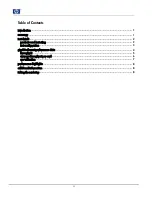
Gigabit Ethernet Performance in rp7410 Servers
introduction
HP leads the industry in PCI Gigabit Ethernet (GbE) performance, reliability, and supportability. With
the introduction of the second generation PCI Gigabit Ethernet Adapters, HP extends its leadership
position.
HP’s new 1000Base-SX NIC solution (using multi-mode fiber cable and supporting distances of up to
550m) and 1000Base-T NIC solution (using CAT5 UTP cable and supporting distances of up to 100m)
both offer the same level of performance with the only difference being cost and distance.
This paper provides basic I/O performance information for the A6825A 1000Base-T and A6847A
1000Base-SX Gigabit Ethernet LAN Adapters when installed in the hp server rp7410. This paper is not
an exhaustive source for HP LAN adapter performance information. It provides a guideline for expected
performance from the A6825A and A6847A Gigabit Ethernet LAN Adapters.
Both the A6825A and A6847A Gigabit Ethernet adapters are designed to maximize server CPU
efficiency with advanced features such as protocol offloading through on-board TCP, UDP, and IP
checksum calculations and optional jumbo frame support (9000 byte maximum transfer unit, MTU) for
improved efficiency and performance with bulk data transfer.
The hp server rp7410 is a highly dependable, adaptable, and efficient midrange server for the data center.
The rp7410 brings added efficiency and economy of operation to the midrange server market.
This paper addresses the performance capabilities of the A6825A 1000Base-T and A6847A 1000Base-SX
Adapters when used in the hp server rp7410.
summary
The hp server rp7410 is an excellent midrange server, and with the HP Gigabit Ethernet NICs provides a
winning combination of capabilities.
The HP Gigabit Ethernet adapters together with the 8-way rp7410 provide outstanding networking
performance, with linear scaling of Transmit data and Receive data for up to 4 cards. Additional cards
may also be added to provide greater connectivity.
Page 1





























